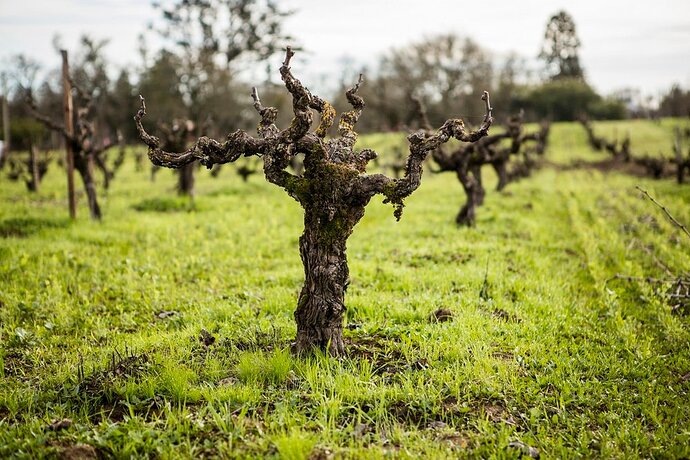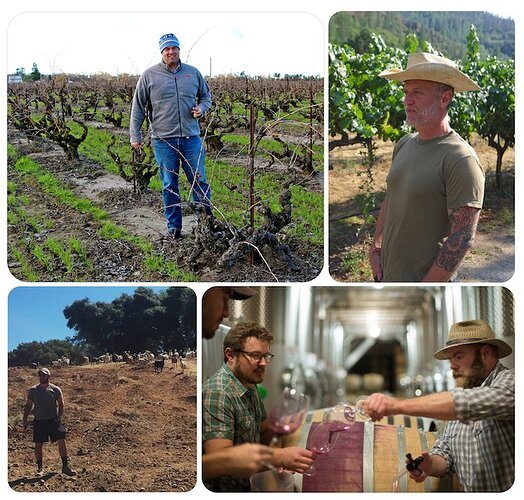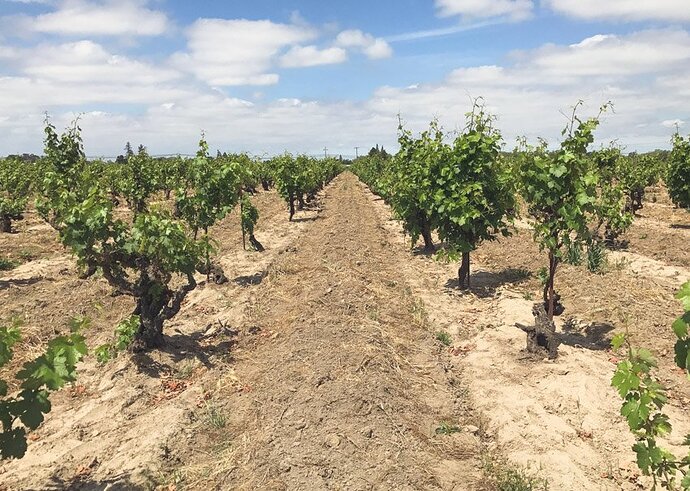Growing Produce website
“Sea Change Coming to California Winegrape Landscape”
by David Eddy
May 24, 2016
"…The declining prices for SJV [San Joaquin Valley] grapes indicates there are just too many of them, notes Nat DiBuduo, President of Allied Grape Growers, the state’s largest grower cooperative with a total of about 600 growers. More precisely, he says there are too many of the older plantings of winegrapes that have largely fallen out of favor, such as ‘Carignan,’ ‘Barbera,’ and ‘French Colombard.’
"DiBuduo, who serves on the Editorial Advisory Board for American Fruit Grower® and Western Fruit Grower® magazines, says growers have been responding by pulling out a lot of acreage of those older varieties. About 21,000 acres of winegrapes were pulled out of the state’s interior between the 2014 and 2015 harvests, triple the amount recorded in each of the five preceding years. And another 13,000 acres have been pulled since the 2015 harvest.
"The pull-outs in the SJV have been underestimated by the state, as have the acres planted in other parts of the state, DiBuduo noted recently. The pull-outs, which were due in part to the state’s drought, aren’t exactly something he likes to trumpet. However, they are necessary to try and balance supply and demand, which definitely benefits growers, says DiBuduo.
“‘It’s more interesting to talk about huge crops during excess or short crops during a shortage,’ he says, ‘but a short crop in a time of ample supply just makes for a boring production story of moving toward balance.’
Though older, this article builds on the concept that the Central Valley of California is losing its edge over the coastal regions in winegrape growing…
California Agriculture, 57(3)
“California’s Wine Industry Enters New Era”
by Dale M. Heien & Philip L. Martin
July 01, 2003
“…The wine industry has been among the most successful of California’s farming sectors. The growing number of educated wine drinkers, optimists emphasize, means that the demand for premium wines can continue to expand. If the demand for jug or generic wines continues to fall, the 21st-century wine industry may operate at very different speeds, with one segment enjoying record profits while another uproots unprofitable grapes.”
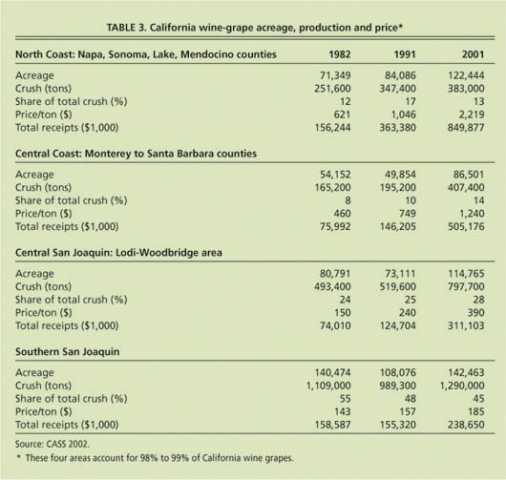
California Agriculture, 57(3)
“Central Valley Growers Pulling Grapevines”
by Editors
July 1, 2003
"…Nearly three-quarters of the acreage uprooted is in Fresno, Kern and Tulare counties, primarily old vineyards or those without grape contracts, Correia reported at the May 30 Vineyard Economics Seminar in Napa. The varieties being pulled are mostly wine varieties, plus older Thompson Seedless raisins and table grapes.
"‘Many of the growers are converting to citrus or almonds,’ [UC viticulture advisor Stephen] Vasquez notes.
“Behind dairy, grapes are the state’s second largest agricultural sector, worth $2.6 billion in 2002. According to a March 2003 California Department of Food and Agriculture report, California crushed 3.8 million tons of grapes (including wine, raisins and table grapes) in 2002, up 12.5% from 2001, while growers received average prices 17% lower than the previous year. Growers without contracts for their grapes faced the lowest spot-market prices in decades.”
LA Times
“Study Indicates that Climate Change will Wreak Havoc on California Agriculture”
by Michael Hiltzik
March 09, 2018
"The California we know is the breadbasket of the nation, producing more than two-thirds of the country’s fruits and nuts, including almonds, pistachios, oranges, apricots, nectarines and prunes, and more than a third of its vegetables, including artichokes, broccoli, spinach and carrots. It’s all valued at more than $50 billion a year.
"That’s the assessment of a recent paper by a University of California team led by Tapan Pathak of UC Merced. But the researchers focused on a different aspect of California agriculture: You can kiss much of it goodbye because of climate change.
"The paper, published in the journal Agronomy last month, is the most thorough review of the literature on the regional impact of climate change in recent memory. It makes grim reading.
"Among the chief manifestations of climate change will be changes in precipitation patterns, leading to more drought and more flooding, and spottier water storage. Generally warmer temperatures, not to mention more frequent and severe heat waves, will reduce yields of wine grapes, strawberries and walnuts; shorter chill seasons will make vast areas no longer suitable for chestnuts, pecans, apricots, kiwis, apples, cherries and pears. Plant diseases and pests will move into regions where they haven’t been a problem before.
"…Put it all together, and the prospect is for a dramatic change in the mix of California produce and overall output. The UC paper foresees a decline of more than 40% in avocado yields, and as much as 20% in almonds, table grapes, oranges and walnuts. (Wine grape yields will be generally unaffected, but their quality might be compromised.)
"…The effects of climate change fall into two main interrelated categories in California, as they do most everywhere: temperature and water. Average maximum and minimum temperatures have been rising in the state, leading to less cooling and more heat waves, especially in inland areas such as the Central Valley.
"…UC Merced’s Pathak says growers and state planners will need to deal with short-term impacts as well as the long-term ones. The near term involves greater variability in weather, namely more droughts and floods. ‘We need to be prepared to mitigate risks to agriculture due to these extreme events,’ he told me. That translates into better flood control, more efficient irrigation and more water storage.
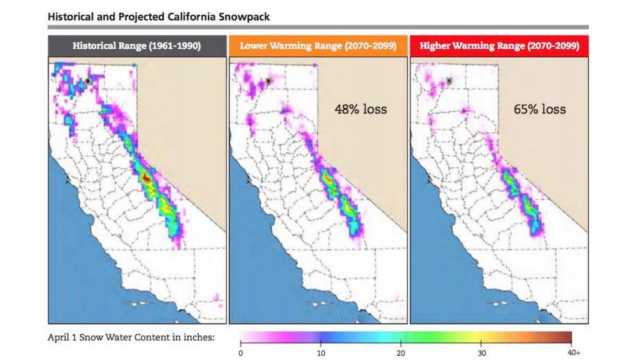
“The longer term requires a more strategic approach. California simply won’t be as suitable — or suitable at all — for some crops that have been identified with California farming for decades. Whatever the strategy, California agriculture is going to look very different at the end of this century than it does today, and the time to start taking stock is now.”[/i]
Lodi Wine Commission Blog
“Premiumization of Lodi Grapes and Wines Addressed at 2018 Lodi Vineyard & Wine Economics Symposium”
by Randy Caparoso
June 29, 2018
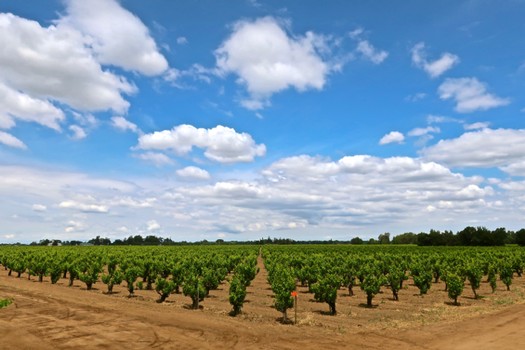
"“Lodi needs to actively fight against commoditization and move more decisively towards premiumization,” said Jeff Bitter, the recently appointed President of Allied Grape Growers; yesterday afternoon at the 2018 Lodi Vineyard & Wine Economics Symposium, taking place at Wine & Roses Hotel in front of an audience consisting primarily of Lodi wine grape growers and producers.
"Both words, premiumization and commoditization, are a mouthful. Bitter was basically pointing out the fact that Lodi wine grape growers are moving towards more expensive, premium quality production; despite the region’s far longer history as a source of grapes of distinctive qualities which, nonetheless, end up becoming homogenized in giant vats of more everyday quality wine (making it an epitome of ‘commoditization’).
"Hence, Lodi’s pertinacious reputation as a second-tier wine region; notwithstanding the growing number of proven, premium quality Lodi grown wines being produced by artisanal wineries inside and outside the region over the past 15, 20 years. A reputation that, in effect, has prevented Lodi growers from establishing higher price points for their grapes.
"…‘Believe it or not,’ said Bitter, ‘red Zinfandel is the poster child for premiumization in Lodi, despite the fact that grapes are sold for as low as $400 to $800 (per ton), yet up to $3000, and the fact that the bulk market is currently swimming in an excess of Zinfandel.’ Bitter added that the ‘opportunities are there’ for Lodi Zinfandel to grow into a premium priced wine because of what’s happening in ‘neighboring districts,’ such as Napa Valley and Sonoma County.
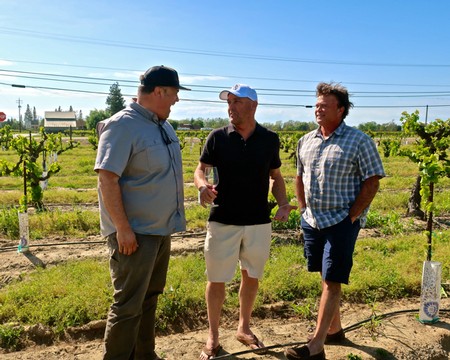
"Mr. [/i][Tegan] Passalacqua – whose Turley Wine Cellars specializes in ultra-premium level Zinfandel and Petite Sirah grown in all the major California wine regions (from Sonoma to Amador County, and from Mendocino down to Paso Robles) – simply related his company’s experience: ‘Everywhere we go in the wine markets across the U.S., we see insatiable demand for high-end Zinfandel – the opportunities are endless out there.’
"Passalacqua made no bones about his perception of the quality of Lodi grown Zinfandel: 'We see no qualitative differences between Lodi fruit and other regions’, despite the price differences… In 2010 we did 92 different Zinfandel ferments – and in all honesty, I’d have to say that 2 of our 3 best Zinfandels that year came from Lodi.
“‘Zinfandel in Napa Valley currently goes for about $4000 a ton, but that’s because there is less and less of it everyday. There is a lot of mediocre Zinfandel in Napa Valley going for $4,200/ton – stuff that I wouldn’t pay for. But it sells because there is a demand for high-end zin out in the market.’
"Part of the price differentials, of course, has to do with the reputations of Napa Valley vs. Lodi. Passalacqua remarked, ‘One of the biggest issues to address is getting people out here to experience Lodi. Most of the industry still doesn’t understand that St. Helena (in the center of Napa Valley) during most summer months has hotter days than Lodi. It’s hard to get people to break out of the mentality that Lodi is not as good.’
"According to Bitter, commenting further on Lodi’s pivot towards premiumization: ‘It starts with growers making that decision, which involves spending more money, investing more time on production and marketing, selling to smaller producers with big reputations, taking a chance, and even accepting a little failure along the way.’
"Peltier Winery’s Rod Schatz agreed with Bitter; saying: ‘The most important thing is having a willingness to change; then you need to invest and up your game…’
"Mr. [Marshall]Miller spoke about his family’s tireless efforts towards ‘branding’ and grower/winery ‘partnerships,’ ever since their first vineyard (Bien Nacido) was established in 1973; while sharing these ideas with Lodi vintners: 'We view our vineyard names as intellectual property, which often makes contractual discussions with wineries a wrestling match. But we believe that if wineries are going to use our vineyard names on wine labels, a certain level of quality needs to be reached. We are selective about who are our branding “partners”. Not all the wineries we sell Bien Nacido grapes to, for instance, are eligible for the use of that name.’
"The Miller family backs up their demands on wineries by farming strictly for quality; plus, by selling grapes by the acre, rather than by the ton, which frees up both the grower and winemaker to establish their vineyard management protocols based upon qualitative needs (as opposed to tonnage).
"…Passalacqua made a similar comment regarding the oft-times contentious grower/winery dynamic; saying, ‘Great farming builds a winemaker’s confidence because every decision you make in a winery is based upon what is done in a vineyard.’
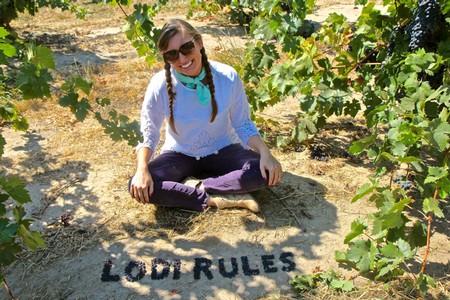
"…Finally, Dr. [/i][Stephanie] Bolton spoke about the Lodi Winegrowing Commission’s ongoing efforts to get growers to develop 6 specific skills – not all of which, she admitted, ‘growers are comfortable doing’:
• Business skills
• Negotiating
• Branding
• Networking
• Promoting
• Agritourism
"The entire idea of putting X amount of money aside each year for marketing or communications, according Bolton, is still something of a foreign concept to most Lodi growers, but ‘it is one of the keys to premiumization.’
"…“One of our Lodi grape buyers told me that when given a choice between grapes that are certified or non-certified, I always pick the grapes with LODI RULES certification.”
“Bolton adds that the LODI RULES organization is also upping its game with support programs; such as the recent launch of a consumer-targeted Web site at LODIRULES.org which aggressively promotes the message and values of sustainable viticulture, while also serving as a source of the growing lists of certified vineyards and wine producers for consumers to reference.
“‘The public is eager to get behind sustainability,’ said Bolton, 'which is why we also need to think more seriously about vineyard agritourism as a way of reinforcing our wine country visitors’ connection to sustainable vineyards – and Lodi is the leader in sustainability…'”
LODI RULES for Sustainable Winegrowing website
LODI RULES for Sustainable Winegrowing website: “Certified Vineyards” Directory
Jake from Bedrock Wine Company hosts this new video on an east-side Lodi vineyard that has been undergoing some remediation for its last leg of existence.
\
57JXvu00Hqc
The story of how Lodi’s “Spenker Ranch” managed to keep a large portion of the historic “Royal Tee Vineyard” in the ground is a lesson for independent land owners struggling with similar challenges today.
After surviving on annual bulk purchases from a corporate giant, Greg Burns developed a mutually-beneficial relationship with a smaller winemaking organization. The improved farming practices taught by the folks at Turley indirectly contributed to the formation of Jessie’s Grove Winery.
Lodi Wine Commission Blog
“Tasting Royal-Tee at Jessie’s Grove”
by Randy Caparoso
December 29, 2010
"…This 5 acre vineyard was originally planted by Joseph Spenker in 1889; so long ago, even American history buffs have trouble recalling who was president then (it was Benjamin Harrison).
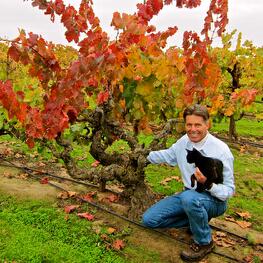
"Today, these majestic vines – twisting, whirling arms rising from tree-like trunks, like graceful, oversized bonsai – produce red wines that are emblematic of the recent growth of Lodi as a region known for ultra-premium wine growing: namely, Jesse’s Grove’s ‘Ancient Vine’ Carignane and ‘Royal Tee’ Zinfandel.
"We can talk into the night about Lodi’s heritage Zinfandels, but it is the ‘Royal Tee’s’ Carignane that is perhaps the vineyard’s definitive wine. The 2006 Jessie’s Grove ‘Ancient Vine’ Lodi Carignane ($32) is full bodied, dry red that staggers the senses as much as the mind: bushels of blackberry and black cherry in the nose. The gushing aromas turn into bright, boysenberry-like flavors on the palate; plump and teeming, like caramelized syrup seeping through a gripping palate.
"…Spenker’s great-great-grandson, Greg Burns, is ‘Royal Tee’s’ current gatekeeper and winemaker/proprietor…Burns shared some of the family history: ‘Although there was a good market for wine grapes 121 years ago, we never produced wine of our own until Jessie’s Grove was bonded in 1999. The winery was named after my great-grandmother, Jessie Spenker, who really was the one who kept the ranch going after Joseph Spenker’s passing at the beginning of the last century.’
"An early environmentalist, Jessie was also the one who set aside 32 of the ranch’s 320 acres, preserving the grove of 100-plus-year-old oak trees that you see today next to ‘Royal Tee’. Continuing the story, Burns tells us, ‘up until the mid-nineties, our grapes were sold almost exclusively to E&J Gallo…Of course, in those days, all contracts were done by handshake.’
"The change came in the mid-nineties, when Larry Turley – the owner of Turley Wine Cellars (if not California’s most prestigious Zinfandel producer, certainly the most cult-like) – came knocking. According to Burns, 'Larry and his assistant winemaker, Ehren Jordan, suggested some cover crops, and helped with the bunch thinning and leaf pulling. During the harvest they drove the tractors pulling the macro-bins themselves, and there were some fantastic Turley zins made from our grapes in ’96, ’97 and ’98.
"‘Naturally, that motivated us to start our own winery. But not all of our old vines were productive. 42 of the original acres planted by my great great grandfather were in very poor, sandy soil, and the plants were very small – half the size of the vines you see in ‘Royal Tee’ – and struggled to produce grapes, struggled to stay alive, especially since they were always dry farmed. So in 1996, we made the heartbreaking decision to pull most of them out and replant; keeping the healthier ancient vines, with the deeper root systems in loamier soil – and that’s the ‘Royal Tee’, affectionately named after one of our brood mares.’
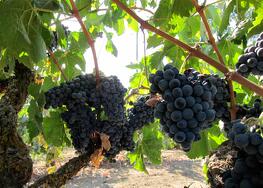
"Talking about the Carignane coming off the ‘Royal Tee’, Burns says, 'the vineyard is interplanted with several grapes – only about four of the five acres is actually Zinfandel, and we mark the odd varieties with ribbons so that the pickers can tell the difference when they pass through. The Carignane adds up to about three-quarters of an acre, and the rest is a mix of Black Prince, and Mission. There is also some classic, old, pink table grape, Tokay, which we use to make a Port.
“‘I believe Carignane vines really need to be at least 100 years to truly express the grape. Even so, not every year. Maybe we’re picky, because we know what a phenomenal wine it can be, from great vintages like ’02 and ’04. We didn’t make an ‘Ancient Vine’ Carignane in ’07 or ’08. The past vintage (2010) was a great one for all of Lodi; but in the fermentor our 2010 Carignane did not quite hit us with the aromatic distinction we look for, and so we decided to blend it into our ‘Westwind’ Zinfandel.’…"[/i]
Not really in-line with the Economics theme, but I needed somewhere to share this!
From the Dry Creek Valley Sonoma Wine Country website (January of 2014):
“What IS a Field Blend Zinfandel?”
"Yesterday, we hosted a virtual live wine tasting for about a dozen wine bloggers from all over the country. The theme was ‘field blend zinfandel,’ and it was lead by winemakers John Olney of Ridge Lytton Springs and Kerry Damskey of Dutcher Crossing Winery; and Assistant Winemaker of Dry Creek Vineyard, Nova Perrill. So what exactly is a ‘field blend zinfandel?’
"Well, let’s first start with the meaning of field blends. A field blend is wine created from several varieties of grapes that were all grown together (same vineyard), picked together and co-fermented. A field blend zinfandel is primarily made from zinfandel grapes, with the addition of a small percentage of other varietals that were planted in the same vineyard as the zinfandel.
“There’s much more to learn about field blend zinfandel, particularly those produced here in Dry Creek Valley. So sit back, relax, pour a glass of wine (we recommend a field blend zin from Dry Creek Valley!) and enjoy this informative, fun and educational discussion by three of our region’s winemakers.”
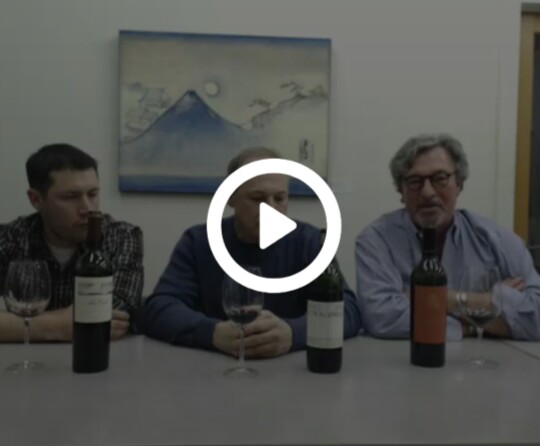
A video of just over an hour of question-answer-format discussion follows, with the three winery gentlemen fielding the questions.
If you have the time, and can crank up the volume, I recommend that you check it out!
What is Lodi getting right that other old-vine wine producing areas are not?
Napa Valley Register
“Lodi Rising: The Region’s Wines are Taking Off and the World is Watching”
by Tim Carl
June 15, 2018
“…Lodi’s rapid rise is largely due to three factors: 1) the cost of land is relatively low; 2) Lodi is large (over 110,000 planted acres, compared to Napa’s 45,000), displaying a wide diversity of microclimates that can grow everything from heat-loving Zinfandel and Cabernet to cooler-climate varietals such as Kerner and Gewürztraminer; and, 3) the culture encourages wine experimentation…”
The Russian River Valley’s “Mancini Ranch” has been under the ownership of Mr Max Reichwage’s eponymous winery for a few years now.
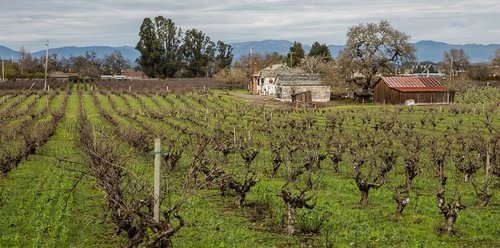
According to the Reichwage website’s profile of the “Mancini Ranch”:
“…We took-over this fairly neglected site in 2015, and ambitiously began chopping back the overgrown black berries, poison oak, removing excess spurs, training-up new trunks, and rejuvenating the soil with compost. We view this special property as a long-term project and it is our hope that the low yields (1 ton/acre) will improve with time, making the farming more economically sustainable.”
A hodgepodge of +22 grape varieties originally was planted in the “Mancini Vineyard” between 1922 and 1924. Mr Reichwage has overseen the addition of the following:
“…Grafted in 2018 in small quantities: Mondeuse, Plavac Mali, Charbono, Trousseau Gris, Touriga Nacional, Chenin Blanc, Clairette Blanche”
The first Zinfandel & Carignan bottlings from the vineyard were offered to email list members on August 28, 2017, during the 2017 Fall Release.
In the September 12, 2018, Fall Release email, Mr Reichwage stated:
“Mancini Ranch: The old vines are looking great this year, the canopy size is the largest I’ve ever seen, and the leaves are staying green well into September! A testament to all the TLC the vineyard has recieved over the past four growing seasons. We will likely be picking here between the end of September, and early October.”
The 2016 Reichwage “Mancini Ranch” RRV Zinfandel (~85% Zin, 15% Mixed Blacks & Whites) ($36/btl) is “from the hill-top sections of Mancini Ranch, what Luca Mancini called ‘Mount Olivet’.”
Reichwage also offers a 2017 vintage vineyard-designated Carignan ($29/btl) from the same Russian River Valley site:
“The Carignane was co-fermented with Grand Noir, Alicante Bouschet, and Aboriou (Early Burgundy), all 100% whole-cluster, with native yeasts and allowed to age for 11 months in large neutral oak puncheons.”
According to the website, the “Mancini Ranch” is one of ten surviving old-vine sites in the Piner-Olivet area of the Russian River Valley. There is a map of the remaining vineyards available on the winery’s web page. Unfortunately, it is a low-resolution image.
Reichwage Winery website:
Bohème Wines produced one Zinfandel, a 2013 bottling from the “Mancini Vineyard”.
Carlisle began offering a “Mancini Vineyard” Zinfandel in 2017 featuring the 2015 vintage, and the 2016 vintage was made available in April of 2018.
Carol Shelton produces a “Mancini Vineyard” Zinfandel every year as well. The 2014 is the current vintage.
Joseph Swan made Zinfandel wines from this special location for many years, either labelled as “Mancini Vineyard” or blended with fruit from the nearby “Ziegler Vineyard”. The “Côtes du Rosa” was a Carignan-dominant wine composed exclusively from “Mancini” grapes; the final vintage of this amazing product was 2012.
Miro Cellars offered vineyard-designated reserve-tier Zinfandels from the “Mancini Vineyard” in the past as well.
EveryVine location of the “Mancini Vineyard”:
http://www.everyvine.com/org/Mancini_Ranch/vineyard/Mancini_Vineyard/
Thanks for this post Drew. I really enjoyed the Reichwage wines at the HVS tasting back in April. Definitely a producer to watch out for.
Here is a cool article about the intervention of smaller wineries, saving old-vine sites that might otherwise have remained unrecognized as potential viticultural gems. Though not every vineyard purchased is old, I am including the piece here as 2 of the author’s subjects did step in to farm or purchase (or both) locations that could have remained unrecognized…
Guild Somm
“Interview: Expats of Napa & Sonoma”
by Kelli A White
September 21, 2017
_"…To shed some light on the complexities of becoming a vineyard owner in contemporary California, I interviewed four winemakers who have settled in five distinct regions—Matt Naumann, General Manager of Hudson Wines; Morgan Twain-Peterson, MW, of Bedrock Wine Company and Under the Wire; Matthew Rorick of Forlorn Hope; and Tegan Passalacqua of Turley Wine Cellars and Sandlands.
"…Kelli White: Tell me about the property you purchased.
"Morgan Twain-Peterson: Our first purchase was eight acres of own-rooted Zinfandel planted in the 1910s in the Mokelumne River AVA in Lodi—just vines in really poor shape. We knew the potential quality of the area, as we bought fruit from our friend Tegan Passalacqua’s ‘Kirschenmann Vineyard’, located about 20 feet away.
"The second purchase was earlier this year when, after several years of friendly negotiations, we bought ‘Evangelho Vineyard’ in Contra Costa County. For me, this is a jewel of California—incredibly healthy, own-rooted Zinfandel, Carignan, and Mataro planted in the 1890s on deep banks of beach sand along the Sacramento River Delta. It has 36 acres under vine and a few small structures on it.
"…Tegan Passalacqua: I purchased [the ‘Kirschenmann Vineyard’] from the granddaughter of the person who planted it; that was the summer of 2012. It is a 20-acre plot with 19 acres of vines and an old trailer, located on the east side of the Mokelumne River in Lodi, about a mile down the road from no place. Fifteen acres of the vineyard were planted in 1915, primarily to Zinfandel with some Carignan, Mondeuse Noir, and Cinsault. The other four acres were originally English walnuts, but in 1991, they planted Zinfandel and Pinot Grigio. I kept the Zinfandel, grafted two acres of the Pinot Grigio over to Chenin Blanc, and ripped out three-quarters of an acre that I am replanting to rootstock._
_"…KW: How did you find your vineyard, and what made you decide to buy it?
"…MTP: We found the vineyard in Lodi, which we have named ‘Katusha’s Vineyard’ as it had no name, when we saw a ‘for sale’ sign on it. A walnut grower was about to purchase it for the land and was going to rip out the vines, which naturally pissed Chris [Cottrell] and [me] off, knowing the potential quality. We made a couple of calls and had an all-cash offer in and accepted in a few days.
"‘Evangelho Vineyard’ we had worked with since 2011 and had become the largest buyer of fruit, so it was a natural transition. However, we also wanted to buy it [because] almost every vineyard in the area is for sale right now, in the hopes a developer will come in. This was a rare vineyard we could afford and protect from the continued eastward Bay Area sprawl.
"…TP: In 2004, I was introduced to this area—there are no less than 12 old-vine vineyards in close proximity. In 2010, Turley started buying Zinfandel from the neighbors. I was overseeing the farming and the then-owner of my vineyard admired the work. Her name was Holly Laske, a Kirschenmann. She and her brother had owned the vineyard, but he had died of cancer in 2004.
"I floated the idea of buying her vineyard, and we set up a meeting. I did my math and presented my number, but it was too low for her. The next morning, I was driving to work, and my phone rang. It was her. She said to me, ‘When I drove by the vineyard last night, I just suddenly knew that my grandfather, father, and brother would have wanted you to have it, so if the offer still stands, it’s yours.’ I fought back tears when I heard that.
“…KW: Why didn’t you buy in Napa or Sonoma? Was cost the main reason?”_
Read the rest of this amazing article here.
Ukiah Daily Journal
**“Ukiah Declines to Support Ag Protection for Lovers Lane Vineyards”**
I found this article last night while surfing the interwebs…
Ukiah Daily Journal
“Easement on Lovers Lane Vineyards in Ukiah Donated to Mendocino Land Trust”
by Justine Frederiksen
January 18, 2019
"About 133 acres of vineyards along Lovers Lane in Ukiah have been protected from development after a ‘conservation easement’ was donated to the Mendocino Land Trust by Paul Dolan and his partners in the Mendo Farming Company.
"Described by Ann Cole, executive director of the Mendocino Land Trust, as ‘Plan B’, the donation of the easement on the 133.5 acres was at least the second attempt to permanently protect the land. A previous attempt by the land trust to purchase an easement at 610 Lovers Lane with $1.7 million from the state’s Sustainable Agricultural Lands Conservation Program was blocked when it did not receive enough support from the Ukiah City Council.
“…‘This project was a unique opportunity to protect vital farmland within the City of Ukiah’s sphere of influence,’ said Cole in a press release announcing the donation, which was made on Dec. 26, 2018. ‘We are pleased that the landowners are eager to protect this historic farmland, even in a time when we know that housing is also important, as we must maintain our critical soils and precious agricultural areas.’
“‘In addition to preserving prime farmland, the protected vineyard provides important scenic agricultural value to the Ukiah residents who live in the area,’ said Doug Kern, director of conservation for the Land Trust. ‘The historic vineyard is also used informally on a daily basis by the local public for walking, which will continue to be allowed.’…”
SALC Program Agricultural Conservation Easement Grants: Lovers Lane Vineyard
download
Mendocino Land Trust
Agricultural Land Conserved at Lovers Lane in Ukiah Valley
Oh, and here is an piece addressing earlier efforts to preserve the historic site:
Ukiah Daily Journal
“Land Trust Looking to Protect Much of Ukiah Lovers Lane Vineyards”
by Justine Frederiksen & Ukiah Daily Journal
March 6, 2018
The “Lovers Lane Vineyard” has been a source of grapes for Harrington’s old-vine Carignan:
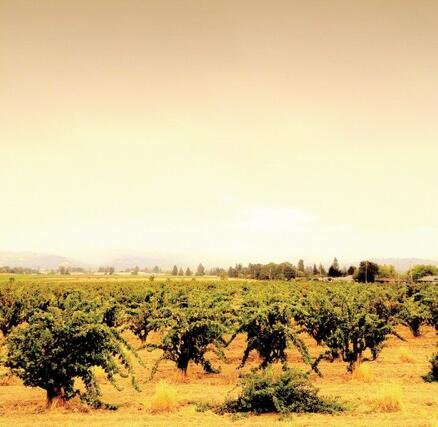
SF Examiner
“New Generation Reviving Longstanding Carignan in California”
by Pamela S. Busch
August 8, 2014
"…Harrington Carignan ‘Lover’s Lane Vineyard’, 2012 (Mendocino County):
“Local vigneron, Bryan Harrington sources his carignan from a Depression-era organic vineyard in Ukiah. It has a bit of weight, but the bright acidity keeps it from feeling fat. With blue fruits, dried leaves, herbs and moderate tannins, it is reminiscent of the best carignans from the Languedoc — Roussillon region of France. No suggested retail price.”
Harrington Wine website:
http://www.harringtonwine.com
Ukiah Daily Journal
“Thompson Joins Selzer Realty”
June 3, 2015
Bud Thomspon and his son Kyle own the “Lovers Lane Vineyard”, as well as Thompson & Son Vineyard Management.
What potentially could sew confusion in the wine-drinking public is the identity of this specific geographical nook. There are several Ukiah growers who reside in Lovers Lane, and there is more than one vineyard that includes “Lovers Lane” in its name:
Mendocino County Winegrapes & Wine Blog
• Profile: “Lovers Lane Vineyard”
• Profile: “Rosewood Vineyards: Lovers Lane”
**California’s Department of Conservation released a survey of the changes in agricultural land acreage (mostly losses) between the years 2000-2008. Comprehensive data for individual counties is available in this large downloadable report:**California Department of Conservation
“2008-2010 California Farmland Conversion Report”
published in 2014
"…During the 13 biennial reporting cycles since FMMP [Farmland Mapping & Monitoring Report] was established, nearly 1.4 million acres of agricultural land in California were converted to nonagricultural purposes. This represents an area larger in size than Merced County, or a rate of nearly one square mile every four days."
Download link (2.9 MB PDF)
Press Democrat
“Statewide Farmland Loss Felt Least in Sonoma County”
by Guy Kovner
"…The net loss of irrigated farmland amounts to a sliver of Sonoma County, which spans about 1 million acres, and about 0.15 percent of its 80,000 agricultural acres. Sonoma had the smallest net loss among the 47 counties included in the report, ranking it just behind 10 counties — including Mendocino — that had net gains in irrigated farmland.
"…The recession limited net urban growth to 473 acres in the county during the report period. Most of the growth was in new housing, schools and schoolyards. The county’s urban growth ranked fourth in the San Francisco Bay Area, behind Santa Cruz with a net gain of 737 acres, San Mateo with 638 acres and Contra Costa with 629 acres.
"…Tim Tesconi, executive director of the Sonoma County Farm Bureau, said the recession that began in 2008 brought local development to a virtual standstill.
Urban growth boundaries also have limited sprawl and protected agriculture, he said.
“‘Our farmlands are sacred,’ Tesconi said. ‘We’ve done a really good job.’
“But the pace of urbanization is ‘likely to speed up again as the economy gets stronger,’ John Lowrie, assistant director of the Conservation Department’s Division of Land Resource Protection, said in a press release…”
**In reference to the above statement, many old-vine sites in Sonoma, Contra Costa, and other counties gain a tenuous “stay of execution” during economic downturns, as landowners often must wait for more prosperous times and an increased interest in commercial development.
This gives readers an opportunity to consider the priorities of those who have a choice between preserving a viticultural heritage site and seeking a more profitable use from the land.
Although conservation easements may be offered to landowners as means of keeping ancient vineyards in the ground, the incentive is not always sufficient. I do not understand the situation sufficiently to comment on how to improve the situation.**
This article falls more under “heritage” than “economics”, but the two are almost always intertwined…
National Museum of American History
“Grape Gluts and Mother Clones: Prohibition and American Wine”
by Paula J. Johnson
May 24, 2018
Fox 40 News
“Lodi Growers Ripping Old Vine Zinfandel Vines Out of the Ground”
by Dennis Shanahan
September 11, 2019
"…Growers FOX40 spoke with said they are battling rising labor costs and changing tastes in the market. There is more global competition these days and the trade war with China is also making it hard to ship wine overseas.
“Lucas also pointed out the governments of some other counties where zinfandel grows subsidize grape growers.
“‘We don’t have that benefit in California, nobody really helps us,’ (David) Lucas (of Lucas Winery) said. ‘We’re out here with these old vines, tending them and hoping that people will enjoy the fruits of the vine’s labor.’…”
This article features a short news video in addition to the text information.
From the Winter 2019 Release - Bedrock Wine Company email:
"Winter Release Letter 2018: The Year it Finally Came Together" (part 1)
"In some strange way, the groundwork for one of the most exciting achievements for Bedrock Wine Co. was laid by an agricultural devastation in the late 19th century. In the late 1870s, Sonoma Valley was as densely planted to grapevines as any place in California, so when the root louse phylloxera vastatrix established itself in the valley’s soils it spread quickly, leaving a trail of decimated vineyards in its wake. The only fortunate result of this agrarian tragedy was that some of the very first vineyards planted on resistant rootstocks were replanted in Sonoma Valley in the late 1880s. Though the valley has some great old vineyards (Fredericks, Maggie’s, Rossi and others come to mind), there are really just four remaining from that initial 1880s replanting, each of which we consider to be among the greatest old vineyards in the world: Monte Rosso, Old Hill Ranch, Pagani Ranch and Bedrock.
"In 2018, we worked with all four of them in the same vintage, a first for any winery and a dream come true for this Sonoma Valley kid. And to top it all off, it was an extraordinary vintage for Sonoma Valley (for more of me waxing poetic about this fantastic vintage, see the fall release letter). Since this release contains the second pair of these—Monte Rosso and Pagani—I figured it would be interesting to go a little more in-depth on each, highlighting some key characteristics which I think defines each site and providing a brief history of each.
“These four vineyards have a few things in common: all planted in the 1880s, all predominately planted to Zinfandel, all make inspiring and age-worthy wines. Apart from those similarities, we get a kind of Venn Diagram of comparisons and contrasts. Monte Rosso and Bedrock Vineyard are both planted in Red Hill Clay Loam but at starkly different elevations. While Bedrock, Old Hill and Pagani are roughly the same elevations, their differences in soil types and their locations within Sonoma Valley make for far different wines. The varietal compositions themselves present a “theme and variations” on Zinfandel: at Bedrock, the hodge-podge of esoteric varieties like Castets and Bequignol; at Old Hill, Grenache and an assortment of Alpine varieties; and at Pagani, Petite Sirah, Alicante Bouschet and other coloring varieties (including Lenoir itself).”
"Monte Rosso Vineyard
Soil: Red Hill Clay Loam
Elevation: 800’ to 1400’
Dominant Varieties: Zinfandel, small amounts of interplanted Alicante Bouschet and Grand Noir
Owner: Gallo Family
“‘Goldstein vineyard, 535 acres of choice hill grape land in full bearing, was sold last week for $32,500 to Martini Grape Products, Inc. The vineyard was owned by the Goldstein family many years and the late Carl Blanckenburg was long its superintendent. The late John Bethune was also employed there. Formerly, excellent wine was made on the place and a fine cellar for crushing and storage maintained, but in recent years the grapes have all been marketed and shipped for manufacture into wine elsewhere…’
-Sonoma Index-Tribune, Oct 14, 1938
"Yep, $60 an acre (closer to $200 a planted acre) is what this vineyard sold for when Louis M Martini bought it from the children of Emmanuel Goldstein in 1938. This, for a vineyard that wine retailing legend Frank Schoonmaker would call “Quite possibly the most beautiful vineyard in California.” What is equally amazing is the vineyard already had a reputation spanning to 1880, when the Goldstein family first started clearing land on the Sonoma side of Mt. Veeder and planting grapes on the mineral-rich, rusted crimson soil.
"Though that first generation of grapevines planted in 1880 quickly succumbed to phylloxera, a fair amount of the second generation of vines, planted on resistant rootstocks in the late 1880s and early 1890s, continue to flourish at the site today. Planted between 800’ and 1400’, Monte Rosso has many different aspects and subtle soil variation— our block of Zinfandel is located in the middle of a beautiful western-facing slope at about 1000’ elevation. Unlike the other vineyards highlighted here, Monte Rosso is nearly pure Zinfandel with only small amounts of the tincturing Alicante Bouschet and Grand Noir interplanted. This makes the long-lived nature of the wines that come from then site even more amazing, as we usually find age-worthiness in Zinfandel-based wines to be somewhat dependent on the presence of mixed black varieties. For me, the best examples off the ranch combine depth of fruit with beautiful, citrus-tinged perfume and noble, lingering structure.
“A couple fun facts about Monte Rosso: we work with the exact same block my father made for Ravenswood from 1993-2002, which makes comparing our young wines versus his older ones quite interesting. The vineyard was nearly 50% white varieties as recently as the ‘70s, with large chunks of Riesling, Sylvaner, Folle Blanch, Traminer, Semillon and a couple Muscat varieties — almost all has been replanted to red varieties, though a few acres of the ancient Semillon still exist.”
From the Winter 2019 Release - Bedrock Wine Company email:
"Winter Release Letter 2018: The Year it Finally Came Together" (part 2)
"Bedrock Vineyard
Soil: Red Hill Clay Loam
Elevation: 175’
Dominant Varieties: Zinfandel, Carignan, Mataro, Syrah, Petite Sirah, Alicante Bouschet, Grand Noir, Trousseau, Tempranillo and more—we are now about to 29 total varieties ID’s including, extraordinarily, varieties such as Castets, Bequignol and Castellana Blanca.
Owner: Peterson Family
"Bedrock is located on the valley floor below Monte Rosso Vineyard. The section of old vines is planted on an alluvial fan derived from Mt. Veeder— the same soils as Monte Rosso— except tossed with basalt and cobble, making it far rockier in appearance and harder on equipment. In some ways the soils are as if the perfect layers of Red Clay and basalt at Monte Rosso were put into a geological blender and poured on the valley floor. The vineyard is quite mixed, with many different interplanted varieties that we pick together as a field-blend and co-ferment. Beyond the field-blended blocks that are generally dominated by Zinfandel, there are also two blocks each of equally old Carignan and Mataro/Mourvèdre that are picked separately and blended back into the finished wine. We estimate the finished wine is usually 45-55% Zinfandel, 15-20% Carignan and 10-15% Mataro, with the balance being the many other varieties found in the vineyard.
“Bedrock is one of the oldest ranches in Sonoma Valley, having first been planted in the 1850s by future Civil War generals William Tecumseh Sherman and Joseph Hooker. The oldest vines date to 1888, when the vineyard was owned by George and Phoebe Apperson Hearst. Purchased by my family in 2004, it was the inspiration for starting the winery in the first place and has become the crown jewel of Bedrock Wine Co.”
"Old Hill Ranch
Soil: Tuscan Cobbly Clay Loam
Elevation: 175’
Varieties: Zinfandel, Grenache, Alicante Bouschet, Petite Sirah, Syrah and more, including a group of Alpine varieties such as Persan, Mollard, Etraire de la Dui and Corbeau.
Owner: Bucklin Family
“Located three quarters of a mile north of Bedrock Vineyard, Old Hill Ranch lies on the next alluvial fan up on the valley floor. Here, the soils also show the red-tinged kiss of iron common on Mt. Veeder derived soils—however, the soils here tend to be less rocky than Bedrock. Organically farmed for as long as anyone can remember, this site is not just great because of its natural high-achieving aptitude but also because of the thoughtfulness of Will Bucklin’s farming. Though also a field blend of a jaw-droppingly high number of varieties, Old Hill is quite unique in that it has a high proportion of Grenache along with a number of Alpine varieties that we have found almost no place else. Old Hill makes some of the longest-lived, Zinfandel-based wines in the world—even the examples my dad made off the ranch in the mid-80s and the wines Merry Edwards made for Mt. Eden in the 1970s are still holding up nicely.”
From the Winter 2019 Release - Bedrock Wine Company:
“Winter Release Letter 2018: The Year it Finally Came Together (part 3)”
"Pagani Ranch
Soil: Haire Clay Loam
Elevation:
Dominant Varieties: Zinfandel, Petite Sirah, Alicante Bouschet, Grand Noir, Lenoir, Carignan, Mataro, Mission/Pais/Criolla Chica, Aramon and more.
Owner: Pagani/Amantite Family
"‘Oh the Pagani…’ -countless fans at public tastings
"In many ways, Pagani Ranch is the greatest outlier of the four vineyards. It lies almost three miles to the north of Old Hill Ranch between the small hamlets of Glen Ellen and Kenwood, on soils derived from the Sonoma Mountain side of the valley rather than Mt. Veeder to the East. Climatically it is also quite different as it tends to receive less of the insulating fog exposure seen by the vineyards to the south— meaning that nights tend to be colder but days, warmer. It also has the highest chance of spring frost damage, which means it tends to be pruned later. This combined with the colder nights means that Pagani is always the last vineyard of the four to be picked— oftentimes over a month after we kick off Sonoma Valley harvest with Monte Rosso. Also a very diverse, field-blended vineyard, Pagani is planted to far more varieties that lend color, tannin and weight to the finished wine, resulting in the most muscular and broad-shouldered wine of the four.
"The ranch is farmed by Dino Amantite, who has been working on the property since he was a teenager (though born in Richmond like my dad, he spent much of his time alongside his Uncle Louie in Sonoma). For many years the fruit went into random bottlings of “Burgundy,” until 1990 when Ridge Vineyards recognized the site’s brilliance and began to vineyard designate it. Thanks to this exposure, Pagani is quite popular when pouring at events like ZAP; Chris and I often joke about the number of times we hear the phrase ‘Oh the Pagani….’ when showing it to the public.
“Thanks to Dino’s oversight, a long-needed replanting of missing vines is underway at the vineyard along with the development of some younger blocks, ensuring the legacy of Pagani will continue for the next generation.”
Bedrock Wine Company website:
https://bedrockwineco.com/
If the vineyard owners are moseying up to the table with the $$$s necessary to rent [or, God forbid, actually own] big iron diesel rigs like that, then there’s no reason whatsoever that the ancient vines couldn’t be simply TRANSPLANTED to new soil.
The animal rights lunatics have all sorts of “Rescue Networks” for vicious pitbulls & ex-racing grayhounds & thoroughbred horses headed to the glue factory.
There’s no reason we couldn’t have an Old Vines Rescue Network, organized so that the owners could inform us when the vines were to be ripped out, and we could arrive with our pickup trucks, and load as many vines as we could haul, and take them home, and transplant them to our backyards.
I don’t know how the California agriculture people would feel about that [in terms of possibly moving insect or mildew species across county lines], but if the transplanting process didn’t cross state lines, then I doubt that the USDA could get involved.
